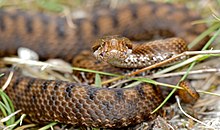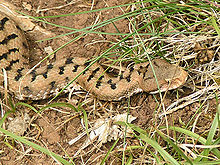Vipera aspis
| Vipera aspis | |
|---|---|

| |
| Scientific classification | |
| Domain: | Eukaryota |
| Kingdom: | Animalia |
| Phylum: | Chordata |
| Class: | Reptilia |
| Order: | Squamata |
| Suborder: | Serpentes |
| Family: | Viperidae |
| Genus: | Vipera |
| Species: | V. aspis
|
| Binomial name | |
| Vipera aspis | |
| Synonyms[4] | |
| |
Vipera aspis is a viper species found in southwestern Europe.
Its common names include asp, asp viper,
Description
The species grows to an average total length of 60–65 centimetres (24–26 in). Males reach a maximum total length of 85 cm (33 in), females rarely more than 75 cm (30 in). Males, however, are a little slimmer than females. The tail is very short: one-seventh to one-ninth of total body length in females, and one-sixth to one-eighth in males.[5]
The head is broad, triangular and quite distinct from the neck. The tip of the snout is slightly but distinctly upturned. The
Midbody, there are 21–23 (rarely 19 or 25) rows of
The dorsal markings vary strongly, but only rarely take the form of a clear zigzag, as in
Common names and historical usage
Common names of Vipera aspis include "asp", "asp viper",[5] "European asp",[6] "aspic viper",[7] "European viper"[10] and "Jura viper".[11] In the past, the term "asp" has been used to refer to any venomous snake.[12]
The snake which supposedly killed the Egyptian Queen Cleopatra is named by Velleius Paterculus as an asp, and by Martial as a viper. Virgil mentions two snakes but does not name their species, while Plutarch mentions twin prick marks on her arm but does not state that these were toothmarks, so they could also have been from a poisoned hair pin. There is a tradition that the bite was a cobra's, but experts consider that a cobra would have been too big (at over 5 feet long) to smuggle in a basket.[13][14]
Geographic range

It is native to
In August–October 2006, a number of specimens were discovered in a wooded area near the town of Poortugaal in the Netherlands. Although they were doing quite well, the species is not native to this country. It is likely that one or more escaped or were set loose in the area.[16][17]
Conservation status
This species is classified as Least Concern according to the IUCN Red List of Threatened Species (v3.1, 2001). So listed due to its wide distribution, tolerance of a broad range of habitats, presumed large population, and because it is unlikely to be declining fast enough to qualify for listing in a more threatened category.
However, subspecies V. a. aspis is categorized as Critically Endangered in Switzerland, V. a. atra is categorized as Vulnerable, and V. a. francisciredi is categorized as Endangered.[1][18][19]
In general, the species is also listed as protected (Appendix III) under the
Habitat


This species has a few clearly defined and relatively specific habitat requirements. It needs warm areas that are exposed to the sun, structured vegetation and comparatively dry soils. In Italy and France, it is often found in areas with low mountains or hills, notably in limestone regions, but sometimes occurs in lower plains. It has a preference for vegetated areas or environments with at least some cover.[5] Here it can be found on sunny slopes, on scrublands, in glades, in mountain meadows, forest clearings, at the borders of woods, in rubbish dumps and in stone quarries.[7] In Italy, it occurs in mesic chestnut/oak woodlands and often near streams.[5] Although it is not strongly associated with high altitudes, it has been found at well over 2,100 m (6,900 ft) above sea level in the Pyrenees.[21]
Venom
A bite from this species can be more severe than from
The toxicity of the venom varies. Stemmler (1971) states that the population in Passwang district,
According to Cheymol et al. (1973), the venom does not affect
Subspecies
| Subspecies[9] | Taxon author[9] | Common name[10] | Geographic range[5] |
|---|---|---|---|
| V. aspis aspis | Linnaeus, 1758 | European asp | Found in most of Mediterranean region, but does occur near Montpellier and in Alpes-Maritimes. A disjunct subpopulation exists in the Pyrenees, notably in Spain southwest of Bilbao. In Germany it occurs in the southern Black Forest along the Swiss border, but is rare in this area. Common in northwestern Italy and western Switzerland .
|
| V. aspis atra | Meisner, 1820 | Black asp | Parts of Switzerland, French and Italian Alps |
| V. aspis francisciredi | Laurenti, 1768 | Central Italian asp | Central Italy |
| V. aspis hugyi | Schinz, 1833 | Southern Italian asp | The south of Italy |
| V. aspis zinnikeri | Kramer, 1958 | Gascony asp | Gascony, Andorra and nearby Spain |
Gallery
A Vipera aspis eating a lizard, Tuscany, Italy.
References
- ^ doi:10.2305/IUCN.UK.2009.RLTS.T61591A12503170.en. Retrieved 19 November 2021.)
{{cite journal}}: CS1 maint: multiple names: authors list (link - ^ The Reptile Database. www.reptile-database.org.
- ^ Boulenger, G.A. 1896. Catalogue of the Snakes in the British Museum (Natural History). Volume III., Containing the...Viperidæ. Trustees of the British Museum (Natural History). (Taylor and Francis, Printers.) London. xiv + 727 pp. + Plates I.- XXV. (Vipera aspis, pp. 481-485.)
- ^ ISBN 1-893777-01-4(volume).
- ^ ISBN 0-89464-877-2.
- ^ a b Vipera aspis at Munich AntiVenom INdex
- ^ ISBN 0-7134-1374-3.
- ISBN 0-7137-1704-1.
- ^ a b c "Vipera aspis". Integrated Taxonomic Information System. Retrieved 13 August 2006.
- ^ ISBN 0-8069-6460-X.
- ISBN 0-486-26629-X.
- ISBN 978-0199206872.
- ^ Stilo, Aelius. "The Death of Cleopatra". Encyclopaedia Romana. University of Chicago. Retrieved 21 October 2015.
- ^ Coughlan, Sean (21 October 2015). "Snake 'not guilty of killing Cleopatra'". BBC. Retrieved 21 October 2015.
- ISBN 3-440-10237-8.
- ^ Uitheemse adder in Poortugaal at Reptielenzoo "Serpo". Accessed 17 October 2006.
- ^ Giftige slangen gesignaleerd in valckesteynse bos at Staatsbosbeheer. Accessed 17 October 2006.
- ^ 2001 Categories & Criteria (version 3.1) at the IUCN Red List. Accessed 2 September 2007.
- ^ Monney JC, Meyer A. 2005. Rote Liste der gefährdeten Reptilien der Schweiz. Hrsg. Bundesamt für Umwelt, Wald und Landschaft BUWAL, Bern und Koordinationsstelle für Amphibien- und Reptilienschutz der Schweiz, Bern. BUWAL-Reihe. 50 pp.
- ^ Convention on the Conservation of European Wildlife and Natural Habitats, Appendix III at Council of Europe. Accessed 9 October 2006.
- ISBN 0-8386-1023-4.
- ^ a b Stemmler O. 1971. Die Reptilien der Schweiz mit besonderer Berucksichtigung der Basler Region. Veroff Nat Mus Basel, Number 5.
- ISBN 0-398-02808-7.
- PMID 5776833.
- PMID 14302278.
- PMID 4766551.
- ^ Gonzalez D (1991). "Snakebite problems in Europe". In Tu AT (ed.). Handbook of Natural Toxins (5th ed.). New York: Marcel Dekker. pp. 687–751.
Further reading
- ISBN 0-00-219318-3. (Vipera aspis, pp. 218–219 + Plates 39-40 + Map 123.)
- Boulenger GA. 1913. The Snakes of Europe. London: Methuen & Co. Ltd. xi + 269 pp. + Plates I.- XIV. (Vipera aspis, pp. 239–246, Figure 36, Plate XIII.)
- Guillemin, Isabelle; Christiane Bouchier; Thomas Garrigues; Anne Wisner & Valérie Choumet (2003). "Sequences and structural organization of phospholipase A2 genes from Vipera aspis aspis, V. aspis zinnikeri and Vipera berus berus venom" (PDF). PMID 12823540.
- Phisalix M. 1968. La livrée des vipères de France (d'apres des notes manuscrites inédites). Bull Mus. Nat. Hist., Paris 40: 661–676.
- Zuffi, Marco A.L. 2002. A critique of the systematic position of the asp viper subspecies Vipera aspis aspis (Linnaeus, 1758), Vipera aspis atra Meisner, 1820, Vipera aspis francisciredi Laurent, 1768, Vipera aspis hugyi Schinz, 1833 and Vipera aspis zinnikeri Kramer, 1958. Amphibia-Reptilia 23 (2): 191–213.
External links
- European Field Herping Community
- Vipera aspis at the Reptarium.cz Reptile Database. Accessed 2 September 2007.
- Vipera aspis at Amphibians and Reptiles of Europe. Accessed 9 October 2006.




